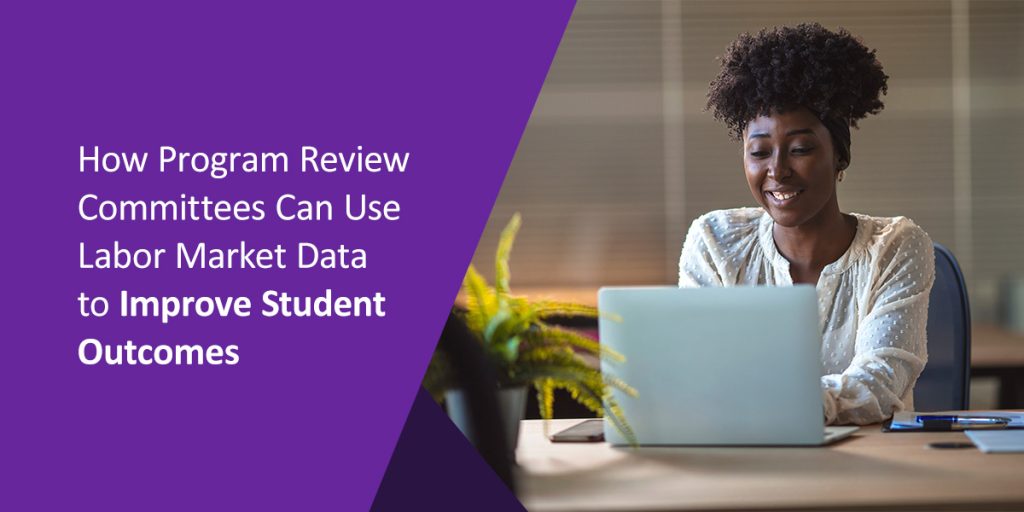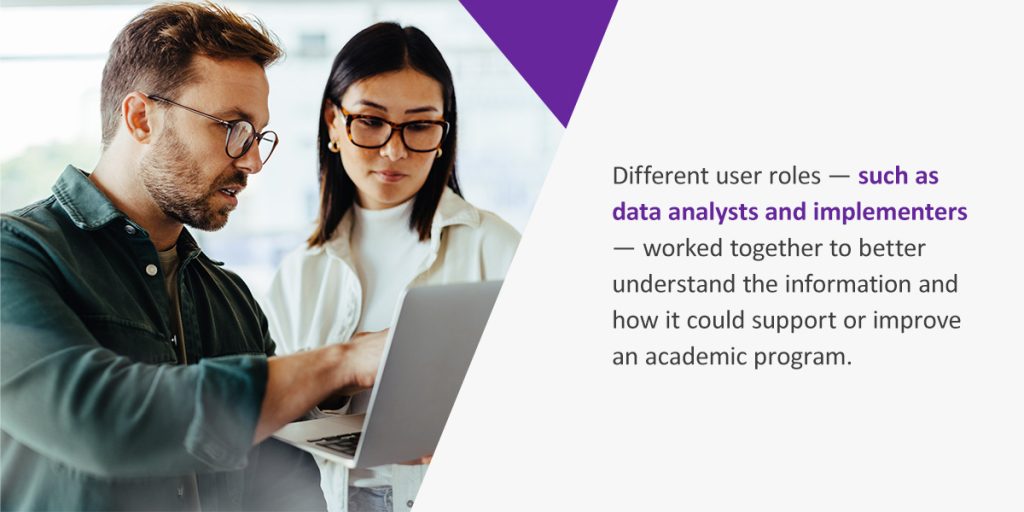
Data collection is a powerful tool for higher education institutions. In a study involving various colleges and universities, 96% of two-year colleges reported using labor market data to research skills required for different careers, as did 70% of public four-year college respondents.
Higher education institutions can leverage labor market data to improve various key performance indicators (KPIs):
- Enrollment numbers.
- Course, program, and curriculum development.
- Graduation rates.
- Financial stability.
- Post-graduation job opportunities.
In this post, we’ll explore how higher education institutions can use various types of labor market information (LMI) to enhance student learning outcomes and success.
6 Ways Program Review Committees Can Use Labor Market Data
Higher education institutions face a unique set of challenges, including enrollment rate reductions, financial challenges, and the need for better career preparation.
In fall 2021, about 15.4 million students were enrolled in undergraduate programs, which is the lowest fall enrollment since 2006. Spring 2023 showed even fewer undergraduate students, with roughly 14.1 million enrollments.
Fortunately, a new wealth of data is helping college administrators and decision-makers confront these challenges. Many higher education institutions use LMI to align their programs with labor market demands, improving student enrollment, retention, and graduation rates. Below are six ways program review committees can use LMI to increase student outcomes.
1. Recruitment and enrollment
Higher education institutions face difficulties maintaining enrollment numbers. Many of these institutions employ trending innovative tools to increase student engagement and enrollment rates. Two creative approaches include:
- Gamification: Gamification integrates game-like elements into learning curriculums. Some examples include point systems and leaderboards to encourage assignment completion and friendly competition among students.
- Microcredentials: Microcredentials enhance specific knowledge areas or skills without the need to earn a bachelor’s degree. These credentials can benefit student engagement and career advancement by providing a shorter, more flexible timeline to achieve a concrete goal. Stackable microcredentials can also pave the way to a full degree or certificate down the line.
2. Student advising
Advisors can encourage students to use labor market data in their career searches and decision-making. Using LMI for student advising can help:
- Highlight potential career possibilities and transferrable skills.
- Connect career interests to relevant jobs.
- Empower students to engage in experiential learning.
Counselors and administrators who stay up-to-date with LMI can better assist students seeking career search advice. They can give students an idea of what to expect when pursuing a specific career path.
3. Program development, review, and improvement
Labor market data collection can help institutions build more formalized program development, review, and improvement processes so programs align more closely with job openings and skill requirements.
A study by Rutgers School of Management and Labor Relations (SMLR) highlighted five critical aspects of program review that LMI could support:
- Increasing program capacity.
- Revising the review process.
- Adjusting delivery modalities.
- Reducing program closings.
- Achieving accreditation.
One participant from a private four-year college reported how LMI could support program capacity expansion. They used the labor market data to increase program offerings — for instance, the recent addition of an Associate of Applied Science (AAS) in cybersecurity and an Associate of Science (AS) in their biology program. Additionally, a survey participant from a public four-year college noted that occupational projections are a valuable basis for boosting program capacity.
Another study by Rutgers SMLR showed that using LMI for program review and development aided decisions to support or reject new and current programs. Multiple participants said that LMI helped create a more holistic program review. These updated program review processes allowed for more intentional growth.

Different user roles — such as data analysts and implementers — worked together to better understand the information and how it could support or improve an academic program. This collaboration may have increased trust in LMI usage, as different users had the opportunity to voice their ideas and concerns.
4. Skills mapping
Skills mapping identifies career-relevant skills in educational programs and courses. It visually maps out the skills, abilities, and knowledge needed to perform a job successfully, comparing that information with what the institution currently provides.
Many liberal arts schools are implementing skills mapping projects and assessments to help prepare students for the future workforce. Skills mapping can help match students with programs and degrees that align with their expertise. Students can better apply the knowledge they learn in class to employability.
Labor market trends suggest a skills-based movement due to the long-term benefits skills mapping can offer. Skills mapping has been shown to improve:
- Employee performance, productivity, and engagement.
- Workforce planning.
- Decision-making.
- Improvement area identification.
- Talent retention.
With that in mind, higher education institutions can incorporate skills mapping opportunities into their curriculums to better equip students with career readiness.
5. Academic and strategic planning
The first-mentioned Rutgers SMLR study showed various efforts by institutions to incorporate LMI into academic and strategic planning. Two-year higher education institutions — which mainly focus on workforce development — were more likely to implement LMI into their academic and strategic planning efforts.
For example, one institution used LMI to pinpoint high-growth areas in the labor market. After identifying these opportunities, they created a series of pathways to respond to those needs, like noncredit preparation and links to credit offerings.
Meanwhile, four-year institutions primarily used LMI to identify focus areas within existing academic planning processes. The participants expressed broad strategic efforts to increase enrollment and students’ employability post-graduation.
6. Developing relationships with external partners
In the first-mentioned Rutgers SMLR study, participants from two- and four-year institutions expressed the value of sharing and discussing LMI with external partners, including:
- Advisory board employers
- Employers not on advisory boards
- Community partners
- State and system offices
For instance, a representative of Gateway Community and Technical College regularly shared and reviewed LMI to inform workforce training and programming.
Another two-year institution shared LMI with local community organizations to identify relevant programs in specific communities. After working with a local professional development center, they found that many local adult residents didn’t have high school diplomas. As a result, they offered general educational development (GED) courses and skills training to provide opportunities for well-paying jobs.
Exchanging LMI with external partners can help cultivate relationships with various groups, build a stronger network and reputation, and better serve community needs.
Incorporate LMI Into Your Processes With Watermark
Higher education institution leaders worldwide are looking to LMI to improve numerous indicators of post-college success, including employment outcomes, career trajectories of different majors, and long-term earnings potential. If you’re looking to leverage and integrate the latest LMI into your program, Watermark offers the Market Landscape Data Pack through its partnership with Lightcast. Your institution can access accurate, consistent data without compromising your existing workflow.
As part of the Watermark Planning & Self-Study solution, the Market Landscape Data Pack enables you to:
- Implement curated LMI into your processes.
- Monitor labor market and demographic trends to improve decision-making.
- Reduce the time spent distributing data to stakeholders.
Learn more about our innovative LMI solutions by requesting a demo today!















































































































































































































































































































































































































